
still need the April edition?
![]() .Events .Moon .Planets .Minor Planets, NEOs .Comets .Shooting Stars .Occultations .Sun .check more! (occultations observers are advised to check in 'Events', and to turn to such dedicated sites like the I.O.T.A). don't forget to check the weather! For the US: the NOAA . color codes: Wwd worldwide, UsA USA-Americas, EuA Europe-Africa, AsP Asia-Pacific, Chk Check for Your Zone. check the site's concept and the instructions of use
.Events .Moon .Planets .Minor Planets, NEOs .Comets .Shooting Stars .Occultations .Sun .check more! (occultations observers are advised to check in 'Events', and to turn to such dedicated sites like the I.O.T.A). don't forget to check the weather! For the US: the NOAA . color codes: Wwd worldwide, UsA USA-Americas, EuA Europe-Africa, AsP Asia-Pacific, Chk Check for Your Zone. check the site's concept and the instructions of use
![]()
 Editor's Choice Fine Picture
Editor's Choice Fine Picture ![]() Editor's Choice Sky At
Editor's Choice Sky At ![]()
![]()
![]() Tech News
Tech News ![]() color codes: Wwd worldwide, UsA USA-Americas, EuA Europe-Africa, AsP Asia-Pacific, Chk Check for Your Zone. check the site's concept and the instructions of use
color codes: Wwd worldwide, UsA USA-Americas, EuA Europe-Africa, AsP Asia-Pacific, Chk Check for Your Zone. check the site's concept and the instructions of use
| Tweet |
.Events Seen All Month Long .Ephemerides Proper
(data from the former yearly ephemerides generator at Fred Espenak's NASA's eclipse website; miscellaneous data with the 'Astronomical Phenomena for The Year 2017,' a joint work by the United Kingdom Hydrographic Office and the U.S. Naval Observatory; to be found at the latter's site; all time UT except otherwise stated)
Wwd The stars of the Great Winter sky are seen West by twilight in the northern hemisphere and the Tropics. That is also true in the southern hemisphere somewhat shifted. Fine visual and photographic opportunities, as that year, further, Venus is also adding like a evening star! Moon will come to add!
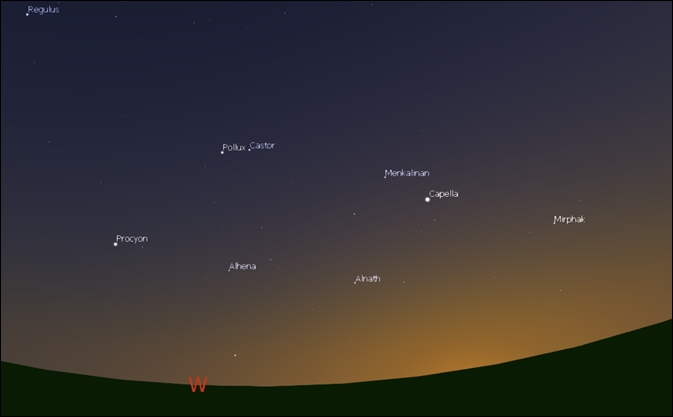 | Great Winter Sky's stars are seen West by twilight as Venus is adding that year! picture site 'Amateur Astronomy' based upon Stellarium |
Wwd A curiosity, the Ariétides shooting stars active late May-early July as they are daytime meteors! more
4 Wwd Moon reaches a southernmost declination at 23:00 UT
5 Wwd The Eta Aquarids shooting stars usually are peaking May 5-6. One of the main shower in the year they are active April 19-May 28 check more back
6 Wwd Moon is at its apogee at 00:35 UT (distances non available)
7 Wwd Moon is at a descending node at 10:24 UT
12 UsA Tomorrow morning by dawn, at all latitudes, very last crescent is seen close to Mercury, where the swift planet is available! Fine visual and photographic opportunities!
13 EuA AsP Tomorrow morning by dawn, by all latitudes, very last crescent is seen close to Mercury, where the swift planet is available! Fine visual and photographic opportunities!
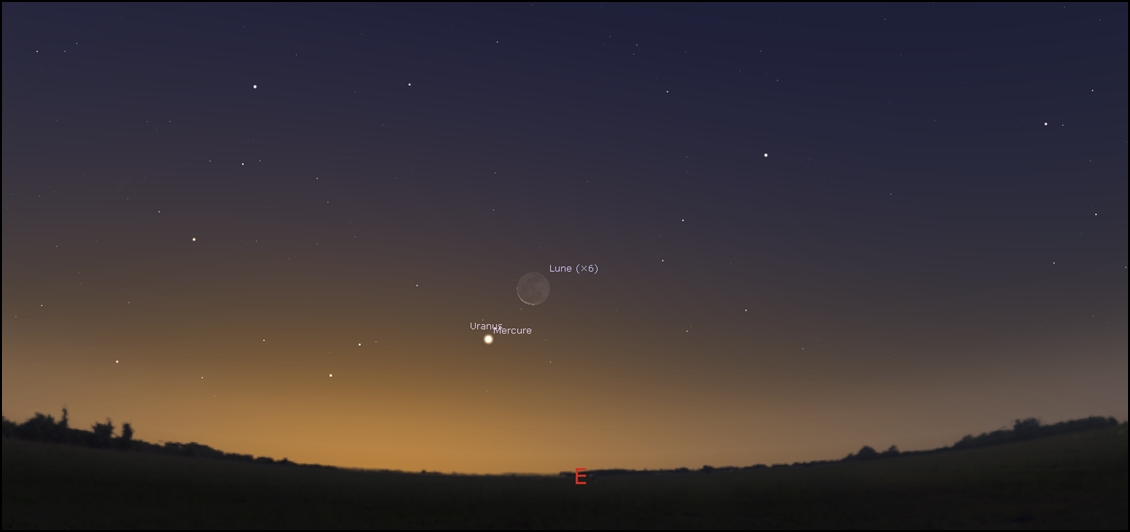 | Where Mercury available like a morning star, Moon is close to it! picture site 'Amateur Astronomy' based upon Stellarium |
16 Wwd There is a occultation of Aldebaran, the bright star to constellation Taurus, the Bull today by Moon! check more at Occultations; check more too at such sites like "The International Occultation Timing Association" (I.O.T.A.)
17 (1) Wwd Very first crescent, by all latitudes, is seen close to Venus in the evening twilight! Fine visual and photographic opportunities! Luminous remnants of the great winter sky are seen in the neighbourhood
 | Moon close to Venus a evening star, in twilight! Fine! picture site 'Amateur Astronomy' based upon Stellarium |
17 (2) Wwd Moon is at its perigee at 21:06 UT (distances non available)
18 Wwd Moon reaches a northernmost declination at 15:02 UT
20 Wwd Moon is at a ascending node at 13:13 UT
21 UsA EuA First quartered Moon, at all latitudes, is close to Regulus tonight, the bright star to constellation Leo, the Lion
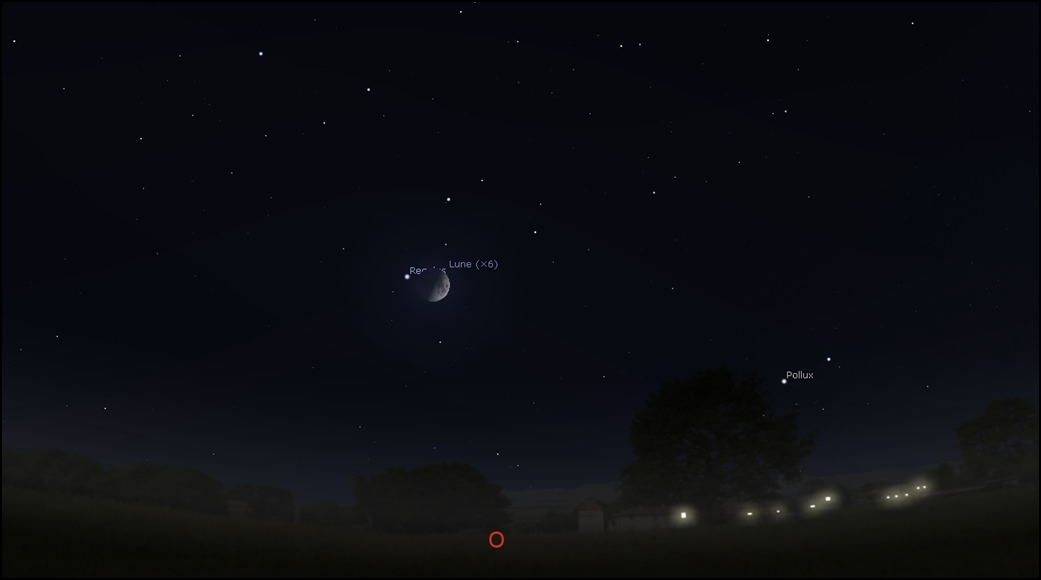 | Moon close to Regulus tonight, the bright star to constellation Leo, the Lion! picture site 'Amateur Astronomy' based upon Stellarium |
22 AsP First Quarter, at all latitudes, is close to Regulus tonight, the bright star to constellation Leo, the Lion
25 Wwd Waxing gibbous Moon, by all latitudes, is close to Spica tonight, the bright star to constellation Virgo, the Virgin
27 Wwd Waxing gibbous Moon, by all latitudes, is close to Jupiter tonight!
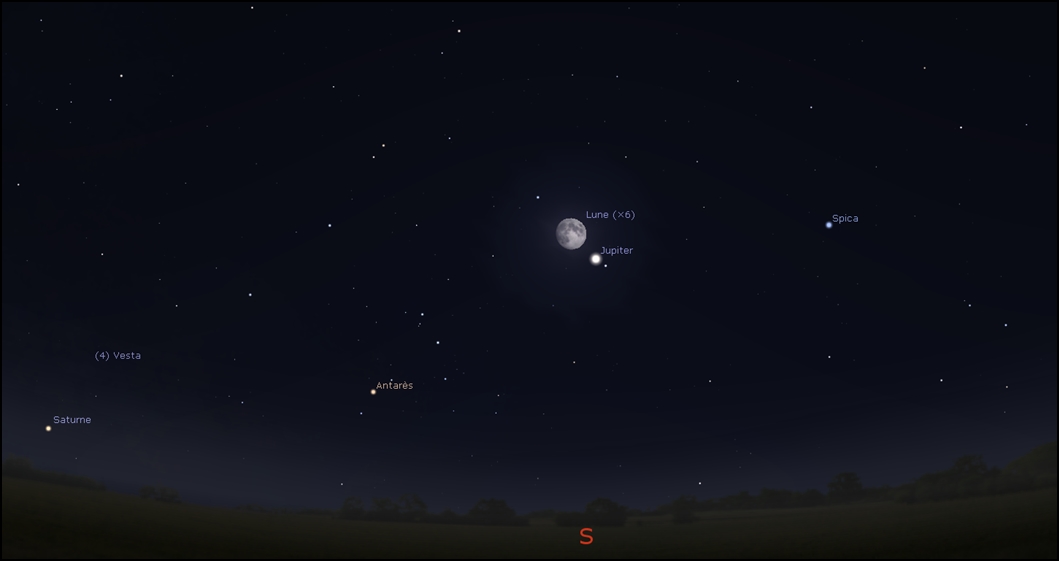 | Moon close to Jupiter tonight! picture site 'Amateur Astronomy' based upon Stellarium |
28 UsA Full Moon, at the Tropics and the southern hemisphere, is close to Antares tonight, the bright star to constellation Scorpius, the Scorpion
29 EuA AsP Full Moon is close to Antares tonight. That is true for the Europe-Africa area at the Tropics and the southern hemisphere only as by all latitudes in the Asia-Pacific one
Occultations observers are advised to turn to such dedicated sites like the I.O.T.A as they may also check below at our Occultation section
Last Quarter is on May 8th, at 02:09 UT
New Moon is on May 15th, at 11:48 UT
First Quarter is on May 22th, at 03:49 UT
Full Moon is on May 29th, at 14:20 UT
(source: ephemeris generator at Fred Espenak's NASA's eclipse website)
Mercury, in May, doesn't reach any remarkable configuration. Mercury is a fine morning star both at the Tropics and the southern hemisphere until mid-May, whence the swift planet will head to the horizon. Mercury is too low in any case in the northern hemisphere to be seen
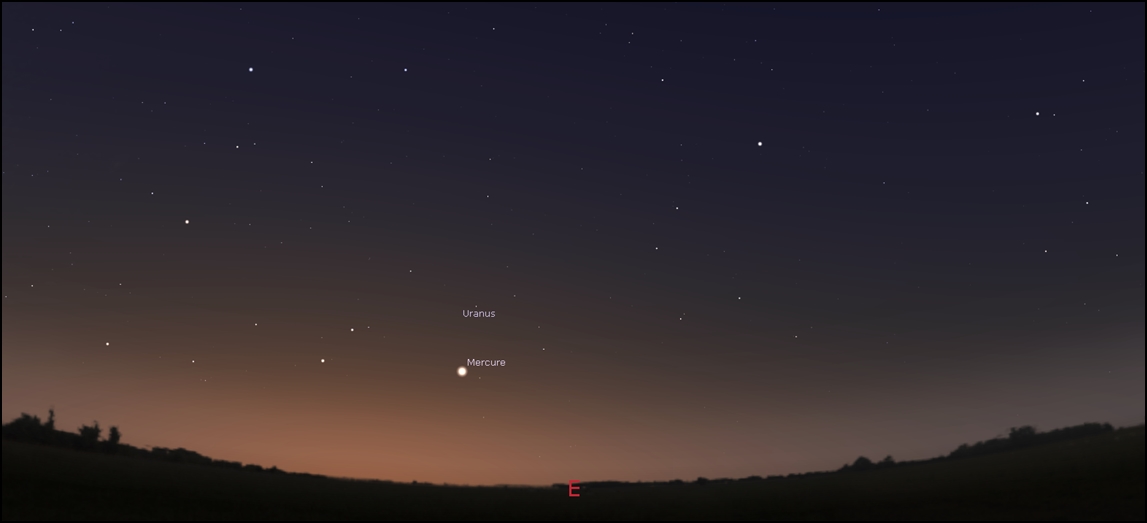 | Mercury a fine morning star at the Tropics and the southern hemisphere! picture site 'Amateur Astronomy' based upon Stellarium |
Venus is now a fine evening in the northern hemisphere where it sets by 10:30 p.m. local time only! Venus further is seen against some luminous remnants of the fine winter sky. That same show is also seen at the Tropics or the southern hemisphere -- albeit lower in that latter case!
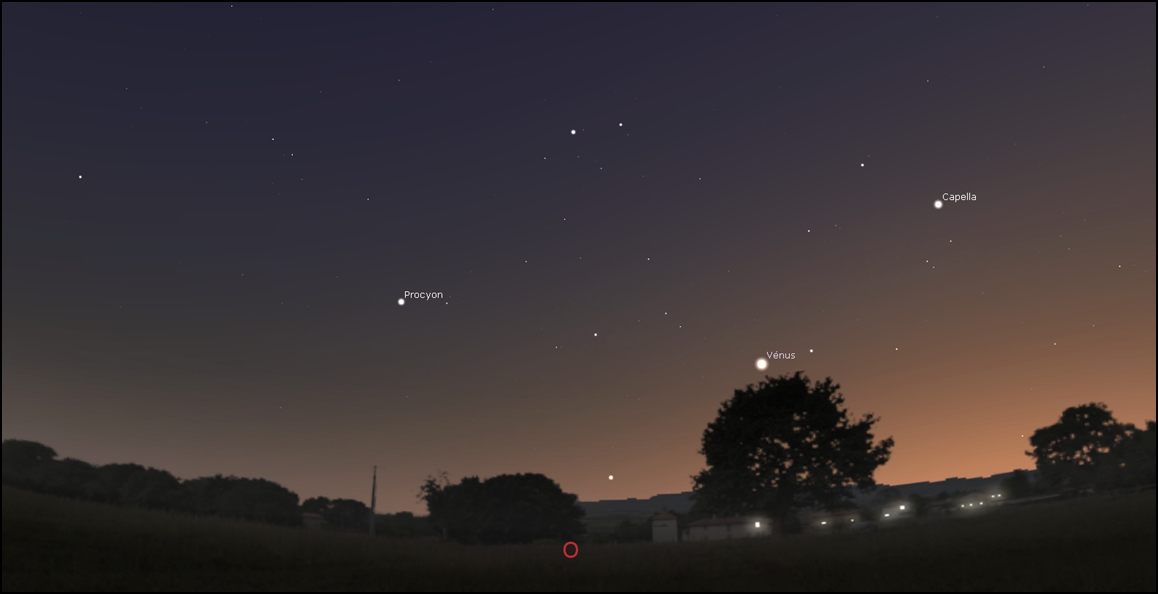 | Venus a fine evening star in the northern hemisphere as it has luminous remnants of the great winter sky like a background! picture site 'Amateur Astronomy' based upon Stellarium |
Mars Mars Observation Campaign! is now rising by 01:36 a.m. local time in the northern hemisphere, as soon as by 11:15 p.m. at the Tropics, and 10:25 p.m. in the southern hemisphere. A Mars Observation Campaign is now unfolding 2018-2019 as it constitutes a remarkable, perihelic opposition, with Mars nearest to Earth at the same time it is nearest to the Sun on its orbit! Mars will reach a 24.2" of apparent diameter at its best as the observation campaign will span from when the Red Planet is reaching, then leaving 6" of apparent diameter! Don't miss those occasions of observing Mars! check more at our Mars Observation Campaign 2018-2019 page
 | Mars by May 15th, 2008! picture site 'Amateur Astronomy' based upon Celestia |
Jupiter At its Best Now! is reaching a opposition, its year's best on May 9th by 00:10! Observe Jupiter! Jupiter in the northern hemisphere, is lying due southeast and quite high. It is much high southeast at the Tropics and about the same in the southern hemisphere. check more about such a configuration of a planet in our tutorial 'Planets Apparent Motion'
 | Jupiter at it's year's best! Observe Jupiter! picture site 'Amateur Astronomy' based upon Celestia |
Saturn Tending to its Best! is closing it's year's best with a opposition to be reached next month! Saturn is now rising my midnight local time in the northern hemisphere. It is already well risen at the Tropics and somewhat more still in the southern hemisphere by 10:30 p.m local time. A ring maximum aperture had been reached in 2017
 | Saturn readying for a year's best! picture site 'Amateur Astronomy' based upon Celestia |
Uranus, after a conjunction last month, remains in Sun's morning glare or in sky by dawn to be observable worldwide
Neptune is rising by 03:40 a.m. local time in the northern hemisphere, 02:15 at the Tropics, and 02:00 a.m. in the southern hemisphere
Pluto now is rising by 00:56 a.m. local time in the northern hemisphere, as soon as by 10:35 p.m. local time at the Tropics or 09:45 p.m. in the southern hemisphere. Pluto in 2018 is reaching a rare 'special' opposition as the latter will occur because the planet will reach its orbit's line of node. (according to the International Astronomical Union (IAU) since 2006, Pluto is not considered a planet anymore, but categorized like a dwarf planet instead along with Ceres, Eris, Makemake, and Haumea, and the prototype of a new category of 'trans-Neptunian', 'Pluto-class' objects)
Minor planets are those biggest asteroids in the Asteroid Belt which may be easily observed by amateurs from the Earth, namely Ceres, Pallas, Juno, and Vesta (due to the new categorization by the International Astronomical Union (IAU) by 2006, Ceres belongs to the 5 dwarf planets in the solar system with Pluto, Eris, Makemake, and Haumea). check data and charts at our section Minor Planets on the yearly Calendar page as our tutorial 'Asteroids and Asteroid Hunting' is of help too. Any remarkable event linked to a minor planet may have a notice here below
Some small asteroids dubbed Near-Earth Objects (NEOs) are regularly making close approaches at Earth. People interested in such close approaches may obtain recent and upcoming data at NASA site Near-Earth Object Program (their section "Close Approaches"). Date, miss distance in AU or Lunar Distance (LD), estimated diameter, and relative velocity are available. For further observational purposes, check at the Near-Earth Object Program ephemeris Generator. For more about NEOs see tutorial "
Once every time, the solar system treats us with a remarkable comet, a eery view spanning up to thirty degrees of sky! Most of the time however comets are the domain of dedicated observers as mostly weak and, at the most, hovering at the limit of the naked-eye visibility. A good site to get information about current such comets is the British Astronomical Association Comet Section page or also the Weekly Information about Bright Comets page (which often points to comets close to the visual magnitude). Our 'Comets and Comet Hunting' tutorial will also be helpful. Remarkable comets otherwise usually will be presented below!
->note: shooting stars afficionados will be aware of checking Moon at the dates of the showers
for more about the meteor showers of this month, for possible other meteor showers for this month, and for more about shooting stars, generally, see our tutorial "Shooting Stars"
Each month, Moon occults some relatively bright stars, that is the Moon, beginning either with its bright or its dark visible face, is passing in front of a star. This is called an occultation. The Pleiades, on the other hand, due to their position near the eclipic, are often occulted by Moon too. Some planets, at last, along the year, may be occulted by Moon or they themselves, or their satellites, may be seen too occulting a star. The asteroids too may occult stars. Yearly lists of such phenomenons are to be found at Sky & Telescope/SkyTonight.com, either in their newsstand issues or at their site, as a list of occultations of most brilliant stars, the planets and the Pleiades are available at the I.O.T.A site (I.O.T.A. stands for "The International Occultation Timing Association"). Most notable occultations are signaled below
Aldebaran back, the bright star to constellation Taurus, the Bull is occulted by Moon on May 16th, 2018 by 13:00 UT! The show is available for central and northern Canada, N.W. Greenland and northernmost central Russia. check more at such sites like "The International Occultation Timing Association" (I.O.T.A.)
check on this site for more about occultations, theoretically
| CAUTION! OBSERVING THE SUN IS DANGEROUS AND REQUIRES DEDICATED SAFE TECHNIQUES! |